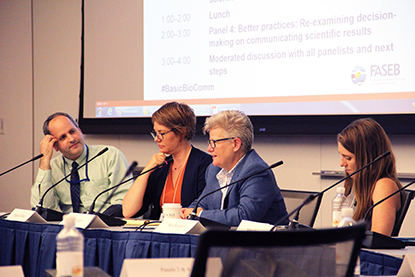News You Can Use
Better Practices for Communicating Science
How to Avoid Hyping Your Research Findings
From tweets and blog posts to press releases and news articles, reports of scientific advances can oversell the findings and misrepresent the discovery process. In fact, when Jon Lorsch joined the National Institute of General Medical Sciences (NIGMS) as its director in 2013, he was struck by the volume of press releases from grantee institutions that hyped incremental findings and gave too much credence to the conclusions from single studies.

PHOTO BY CHRISTA REYNOLDS, NIGMS
From left: NIGMS Director Jon Lorsch moderates a panel discussion during the June 22 workshop with Angela DePace (Harvard Medical School); Lee Ligon (associate professor of biological sciences, Rensselaer Polytechnic Institute, Troy, New York); and Sara Reardon (reporter, Nature) on better practices for communicating scientific results.
These observations—and growing concerns about the negative consequences of hyped research on the scientific enterprise and public trust—helped to spark a roundtable discussion organized by the Federation of American Societies for Experimental Biology (FASEB) and hosted by NIGMS. The workshop, which took place on June 22, 2017, brought together a diverse group of science communicators: researchers, including those who study communications; academic and corporate communications officers; policy advisors; and journalists. Although the panelists focused on basic biomedical research, their discussions and suggestions were relevant to all areas of science.
Hype is “exaggerating the outcomes of research, for whatever motives people have, leading to potential negative effects due to inaccurate portrayal of research,” according to keynote speaker Erika Check Hayden, a veteran science journalist and director of the Science Communication Program at the University of California, Santa Cruz (Santa Cruz, California).
Throughout the day, panelists described each of their incentives for science communications and shared cautionary tales of overstating outcomes. Examples of the latter included news-making results that were quickly refuted, attention-grabbing press-release titles that misrepresented the research’s focus, and articles on lab findings that prematurely raised the hopes of people suffering from diseases such as cancer.
Panelists also described inherent features of science that make communicating about it challenging. When discussing research advances, they encouraged science communicators to describe the complexity and uncertainty of science. Providing these details, rather than glossing over them, helps convey that science generally moves forward through the combined efforts of many groups publishing results over long periods of time—and that scientific understanding can change as more findings become available.
To help bridge the gap between scientists and the public, systems biologist Angela DePace, associate professor of systems biology at Harvard Medical School (Boston) urged her colleagues at the workshop to think of everyone as a scientist, but at different scales of resolution—curious about the world, but approaching it from different points of knowledge and experience. She and other panelists also stressed the need for more communications training programs geared toward scientists.
Panelists offered additional recommendations for the full range of science communicators, including:
Use a scientific approach to communications by developing and following a logic model to outline both long-term and short-term communication goals.
Know when to release news to public audiences. Panelists agreed that careful consideration should be given to deciding when to go public with findings. Not every finding out of every lab should be publicized; waiting until findings are replicated also can prevent premature announcements.
Rather than focusing on a single paper or result, delight in details about the research process. To illustrate this point, Hayden shared a news article on the difficulties of obtaining blood samples from Ebola survivors in Sierra Leone, because there were not yet any results to report.
Tell a good story. The panelists urged all communicators to emphasize the personal story and the enthusiasm behind the science itself. Another example from Hayden featured a scientist who, as a child, fantasized about shrinking herself to the size of a molecule or protein and now works as a structural biologist who lives in that miniaturized world each day.
Be accessible. Accessibility includes swapping technical language for metaphors, analogies, and illustrations as well as taking the time to discuss research with colleagues, communications officers, reporters, and members of the community.
Talk to family, friends, and others in existing social networks about ongoing studies, because that informal discussion can have a powerful influence on informing and exciting the public about science.
As a final tip, the panelists noted that there are many resources available to help hone skills for disseminating science to a broad audience (see sidebar in online version of the NIH Catalyst for NIH resources) and that these skills can translate to other biomedical careers such as policy advisors, public-information officers, journalists, and educators.
To watch a videocast of the June 22 workshop, go to https://videocast.nih.gov/launch.asp?23374. For more details about the workshop, including a meeting summary, click here.
NIH Resources on Communicating Science
Checklist for Communicating Science and Health Research to the Public
Infographic on Explaining Different Kinds of Clinical Studies
Infographic on Understanding and Communicating Health Risks
Science, Health, and Public Trust Blog
Plain Language Writing Tips and Resources
Writing Resources from NIH’s Office of Intramural Training & Education
This page was last updated on Friday, April 8, 2022
